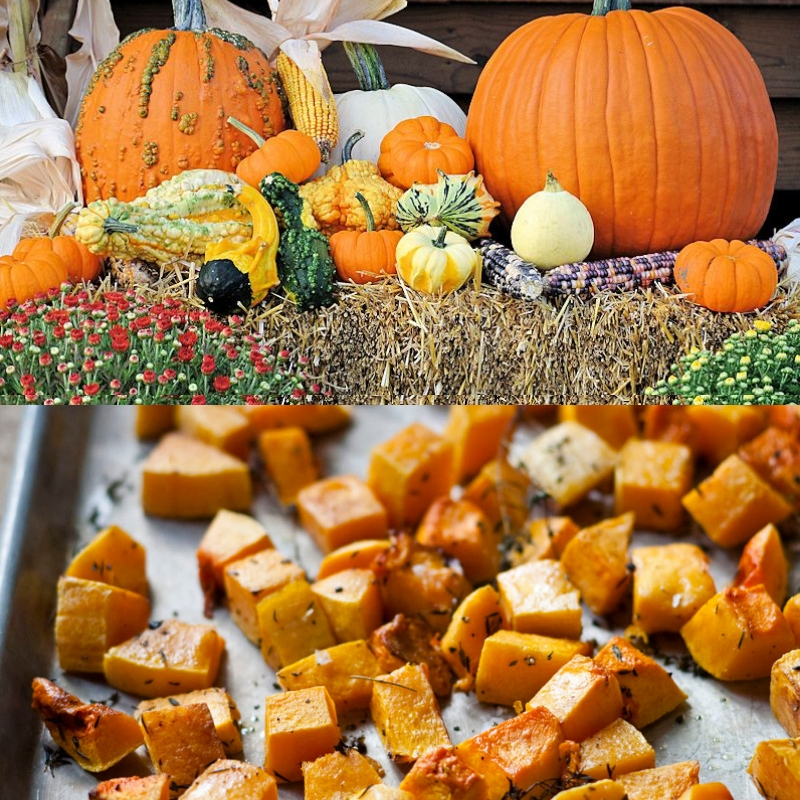Fall Squash - As Good to Eat as They are Decorative
TEXARKANA, Ark. –
With the weather turning cooler, people begin to spruce up their home with fall decorations of scarecrows, bales of hay, mums and of course colorful pumpkins and squash.
While many decorate with those pumpkins and squash, did you know these fall vegetables are good to eat?
The squash family (Cururbitaceae) includes pumpkins, summer squash and winter squash. Most people think of them as decorations, but they are edible gourds. Their tough outer shells can be smooth or bumpy, thin or thick and rock hard with a wide array of colors.
The most popular winter squash varieties include acorn, buttercup, butternut, Hubbard, spaghetti, sweet dumpling, and Terk’s Turban.
Winter squash is planted in the spring, grows all summer and is harvested at the mature stage in early autumn before the first frost. You will find locally grown, fresh winter squash at local Farmers Markets as well as local grocery stores.
Health benefits of squash
Winter squash is a source of complex carbohydrates and fiber. Carbohydrates give our bodies energy and help our brain to function properly. Fiber absorbs water and becomes bulky in the stomach. It works throughout the intestinal track, cleaning and moving waste quickly out of the body. Research suggests that this soluble fiber plays an important role in reducing the incidence of colon cancer.
Winter squash is also a source of potassium, niacin, iron, and beta carotene. As a general rule, the deeper the orange color, the higher the beta carotene content. Beta carotene is changed into Vitamin A in the body, which is essential for healthy skin, vision, bone development, and many other functions in the body.
Preparing & cooking winter squash
When preparing winter squash for meal preparation, peeling the squash can be a challenge. The thin-skinned varieties, such as acorn, butternut, delicata and sweet dumpling, can be peeled with a paring knife or vegetable peeler.
To peel tough skin varieties, position the squash on a cutting board, stem end facing you. Place the blade of a heavy chef’s knife horizontally along the length of the squash. With a hammer or mallet, repeatedly hit the back of the blade near the handle to drive it into the squash until it breaks in half. Once the squash opens it will be easier to peel. Scoop out the seeds and strings and discard, or save the seeds for roasting.
To cook winter squash, place unpeeled pieces cut sides down on a shallow baking dish and bake in a 350 degree oven for 30 minutes or longer. Check for doneness by piercing with a fork. When tender, remove from the oven and allow the pieces to cool. Spoon out soft flesh and mash with a fork or process in a blender or food processor. Peeled pieces can be cut into cubes and boiled until tender. Use with any recipe calling for cooked mashed or pureed squash.
Small acorn squash and spaghetti squash can be pierced with a long-tined fork or metal skewer and baked whole. Piercing the skin prevents the shell from bursting during cooking. Place the squash on a baking dish and bake for 1 and one half to 2 hours at 325 degrees. When the shell gives a bit with pressure, it is done.
Be adventurous this season and try one of the many winter squash varieties available as a compliment to your main dish instead of using them just for decorations?
These Pumpkin Chocolate Chip Muffins are delicious for breakfast, or as a snack.
Pumpkin Chocolate Chip Muffins
- 3/4 cup white sugar
- 1/4 cup vegetable oil
- 2 eggs
- 3/4 cup pumpkin
- 1/4 cup water
- 1 1/2 cups all-purpose flour
- 3/4 teaspoon baking powder
- 1/2 teaspoon baking soda
- 1/4 teaspoon ground cloves
- 1/2 teaspoon ground cinnamon
- 1/4 teaspoon salt
- 1/4 teaspoon ground nutmeg
- 3/4 cup semisweet chocolate chips
- 1 cup chopped pecans or walnuts (optional)
-
Preheat the oven to 400 degrees F.
-
Grease and flour muffin pan or use paper liners.
-
Mix sugar, oil, eggs.Add pumpkin and water.
-
In separate bowl mix together flour, baking soda, baking powder, spices and salt.
-
Add wet mixture and stir in chocolate chips and nuts.
-
Fill muffin cups two thirds full with batter.
-
Bake in preheated oven for 20 to 25 minutes. Remove from the oven, and cool it on a rack.
For more information, contact the Miller County Extension Office, 870-779-3609 or visit us in room 215 at the Miller County Courthouse. We're online at cdue@uada.edu, on Facebook at UAEXMillerCountyFCS/CarlaDue, on Twitter @MillerCountyFCS or on the web at uaex.uada.edu/Miller.
By Carla Due
County Extension Agent - FCS
The Cooperative Extension Service
U of A System Division of Agriculture
Media Contact: Carla Due
County Extension Agent - FCS
U of A Division of Agriculture
Cooperative Extension Service
400 Laurel Street, Suite 215 Texarkana AR 71854
(870) 779-3609
cdue@uada.edu
The Arkansas Cooperative Extension Service is an equal opportunity institution. If
you require a reasonable accommodation to participate or need materials in another
format, please contact your County Extension office (or other appropriate office)
as soon as possible. Dial 711 for Arkansas Relay.
Pursuant to 7 CFR § 15.3, the University of Arkansas System Division of Agriculture
offers all its Extension and Research programs and services (including employment)
without regard to race, color, sex, national origin, religion, age, disability, marital
or veteran status, genetic information, sexual preference, pregnancy or any other
legally protected status, and is an equal opportunity institution.
